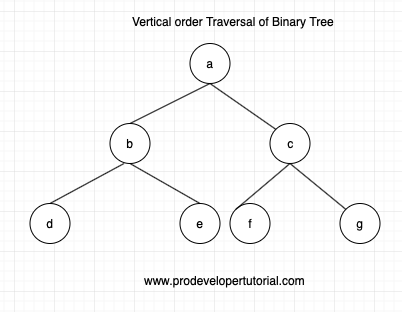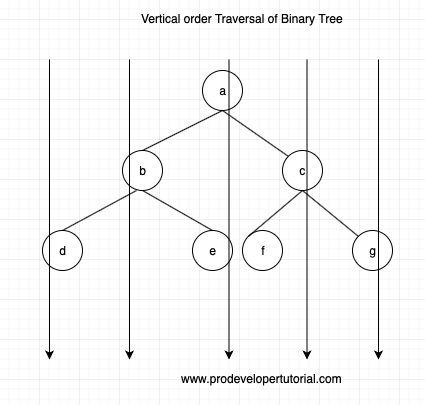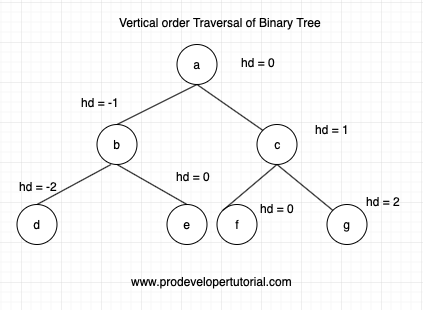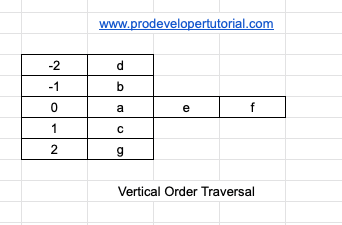In this tutorial we shall see how to do vertical order traversal.
Problem Statement:
You are given a root node of a tree, you need to print the nodes when they are traversed vertically.
Consider the tree given below:
The vertical order traversal can be visualized as below:
So the vertical order traversal will be:
d
b
a e f
c
g
So how can we arrive at this result?
We can arrive at the result with the help of:
- Map
- Horizontal Distance
- Level Order Traversal
We shall see how all these 3 takes part in arriving at the solution.
First how to calculate horizontal distance?
We can calculate horizontal distance by below steps:
- For root node, horizontal distance = 0.
- For left node, horizontal distance = parent horizontal distance – 1
- For right node, horizontal distance = parent horizontal distance + 1
Now, let’s calculate horizontal distance for all the nodes.
As “a” is root node, it’s distance is 0.
b = 0 – 1 = -1
d = -1 – 1 = -2
c = 0 + 1 = 1
g = 1 + 1 = 2
e = -1 + 1 = 0
f = 1 – 1 = 0
Finally, the horizontal distance will look like below:
Now in the hash map, sort the horizontal distance value according to ascending order. Then insert the nodes according to their Horizontal Distance [HD] value.
The hash map will look like below:
Now a question arises. Why we inserted “a, e, f” in that order?
We added it with the help of level order traversal. When we do level order traversal, we get those 3 nodes in that order.
We get our result.
Solution in C++
#include <iostream>
#include <vector>
#include <map>
using namespace std;
// structure to hold binary tree node
struct Node
{
int data;
Node *left, *right;
Node(int data)
{
this->data = data;
this->left = this->right = nullptr;
}
};
void perform_vertical_order_traversal(Node *root, map<int,vector<int>>& map, int h_dist)
{
// Base case
if (root == NULL)
return;
map[h_dist].push_back(root -> data);
perform_vertical_order_traversal(root -> left, map, h_dist - 1);
perform_vertical_order_traversal(root -> right, map, h_dist + 1);
}
int main()
{
Node* root = nullptr;
/* Binary tree:
16
/ \
/ \
10 25
/ \ / \
/ \ / \
7 15 18 30
*/
root = new Node(16);
root->left = new Node(10);
root->right = new Node(25);
root->left->left = new Node(7);
root->left->right = new Node(15);
root->right->left = new Node(18);
root->right->right = new Node(30);
map<int,vector<int>> myMap;
perform_vertical_order_traversal(root, myMap, 0);
cout<<"The vertical order traversal is"<< endl;
for (auto it = myMap.begin(); it != myMap.end(); ++it)
{
for (int i=0; i< it->second.size(); ++i)
cout << it->second[i] << " ";
cout << endl; }
return 0;
}
Output:
7 10 16 15 18 25 30



